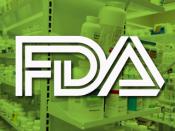Scientific evidence shows that consumption of saturated fat, trans-fat, and dietary cholesterol raises low-density lipoprotein (LDL), or "bad cholesterol," levels, which increases the risk of coronary heart disease (CHD). According to the National Heart, Lung, and Blood Institute of the National Institutes of Health, more than 12.5 million Americans have CHD, and more than 500,000 die each year. That makes CHD one of the leading causes of death in the United States. To describe the attributes of trans-fats as it relates to McDonald's, we will first explain what trans-fats are, are all fats the same, what can be done to eliminate trans-fats from your diet, and last we will examine several common food choices and the nutritional value associated with them (U.S. Food and Drug Administration, 2003).
What is Trans Fat?The food and drug administration defines trans-fats as: "trans fat is made when manufacturers add hydrogen to vegetable oil--a process called hydrogenation.
Hydrogenation increases the shelf life and flavor stability of foods containing these fats" (U.S. Food and Drug Administration, 2003). Trans-fats can be found in vegetable shortenings, some margarines, crackers, cookies, snack foods, and other foods made with or fried in partially hydrogenated oils.
Are All Fats the Same?Simply put: No. Fat is a major source of energy for the body and aids in the absorption of vitamins A, D, E, and K and carotenoids. Both animal- and plant-derived food products contain fat, and when eaten in moderation, fat is important for proper growth, development, and maintenance of good health. As a food ingredient, fat provides taste, consistency, and stability and helps you feel full. In addition, parents should be aware that fats are an especially importantsource of calories and nutrients for infants and toddlers (up to 2 years of age), who have the...


